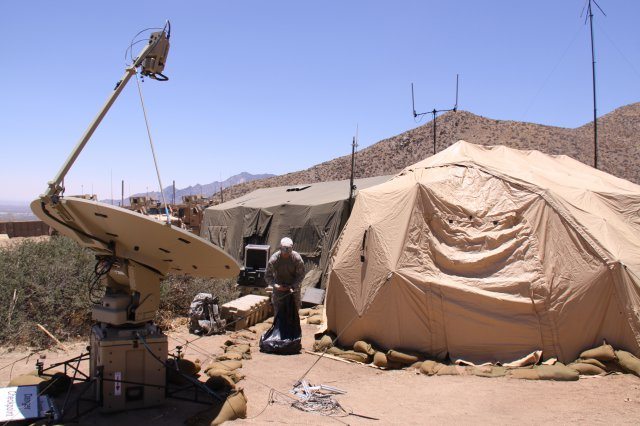With its first Network Integration Evaluation in the rear-view mirror, the Army is gearing up for the next installment in a series of major field exercises designed to rapidly advance its tactical network.
Like the first Network Integration Evaluation, or NIE, which took place in June and July, the October-November NIE will involve the 3,800 Soldiers of the 2nd Brigade, 1st Armored Division (2/1 AD) and nearly 1,000 vehicles spread across the challenging terrain of White Sands Missile Range, N.M. and Fort Bliss, Texas. It will again test the maturing tactical network in a completely integrated manner, using Soldiers conducting realistic missions to determine performance, while introducing promising and emerging technologies for the first time.
“The first NIE was a major leap forward in maturing the network because we evaluated the network holistically in an operationally relevant environment and we were able to conduct testing, integration and user feedback simultaneously,” said Col. John Wendel, deputy program executive officer for Network Integration at the Program Executive Office Integration (PEO I). “As we focus on the next NIE, we must leverage that momentum to meet what the Army has determined is its highest modernization priority.”
The next NIE, known as the Network Integrated Evaluation 12.1, is the second of four events leading up to a fully integrated Brigade Combat Team Network Evaluation at the end of 2012. NIE 12.1 will build upon the end-state of the first event, NIE 11.2, which was the Army’s largest network field exercise to date.
It will again bring together programs of record and developmental and emerging capabilities in an integrated environment — so each component can be evaluated as part of the larger, overarching network that will enable Soldiers at every echelon of the brigade to rapidly share information and execute their mission.
Joining the government and industry players with a stake in the network at a single test event means program officials must “get dirty” and make sure their systems fit into the overall system-of-systems construct, said Clifton Basnight, a system-of-systems engineer with the Program Executive Office Command, Control and Communications-Tactical, or PEO C3T, the network lead organization for the NIEs.
“It forces people away from looking at silos,” he said.
The twice-a-year NIE approach also synchronizes and streamlines the evaluation and feedback process, ultimately leading to quicker fielding and improved end products sent to the field.
As NIE 12.1 approaches, trainers, field support representatives, and other personnel are already on the ground at White Sands and nearby Fort Bliss, installing systems and familiarizing troops with the hardware and software.
Army engineers are also refining the network architecture, which includes terrestrial satellite systems, vehicle-mounted networking radios that pass data as well as voice communications, an aerial tier of radios attached to Unmanned Aerial Systems, or UAS, and a commercial 3G network to evaluate smartphones.
The event will leverage the network end-state from NIE 11.2 as the baseline for additional technologies, while relying on core current and next-generation systems such as the Warfighter Information Network-Tactical, known as WIN-T, the Joint Tactical Radio System, or JTRS, and the Joint Capabilities Release, or JCR, of Force XXI Battle Command Brigade and Below/Blue Force Tracking, which is known as FBCB2/BFT.
“It’s really an ongoing process,” said Chad Claussen, network integration branch chief for PEO C3T’s Technical Management Division. “As we got into the (first) event, changes were being made last minute, great ideas came down. So the engineering process never stopped, and I don’t think we expect it to as these events roll into each other.”
A major development for NIE 12.1 is the participation of WIN-T Increment 2, which for the first time will provide on-the-move network communications all the way down to the company level. While WIN-T Increment 2 is not under formal test until spring of 2012, more than a dozen sets of the equipment have been installed on vehicles for use in the NIE 12.1.
“Army senior leadership has recognized that the cornerstone of modernization is the network, and WIN-T Increment 2 delivers that high capacity network on-the-move,” said Lt. Col. Robert Collins, product manager for WIN-T Increment 2, which is assigned to PEO C3T.
Another important component of NIE 12.1 is the Initial Operational Test and Evaluation of the Rifleman Radio, part of the JTRS Handheld, Manpack, Small-Form Fit, or HMS, program. The Rifleman Radio is a key component to building the ground-level lower tactical network, bringing the most communication disadvantaged users — the small unit down to the individual user — into the network.
NIE 12.1 will also introduce industry participation into the NIE evaluation cycle based on capability gaps identified by the Army Training and Doctrine Command. To evaluate which systems to include in each exercise, the Army sent “sources sought” requests asking industry to propose technological solutions to meet those gaps. PEO Integration led the effort to assess those submissions, match them to known requirements, and assess the maturity and integration potential of each technology.
“This adaptive and quick-reaction acquisition methodology, referred to as the ‘agile process,’ will allow our network modernization to keep pace with industry advances,” Wendel said. “At the same time, the government serves as lead integrator to ensure the solutions are interoperable with one another and inserted on a timetable aligned with the Army Force Generation cycle.”
The Army will host an Industry Day at White Sands on Sept. 8, allowing industry representatives to meet with Army senior leaders and NIE managers to discuss the NIE process and tour the test ranges. Integration work and rehearsals will continue through the start of the event in late October.










